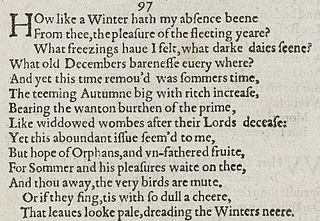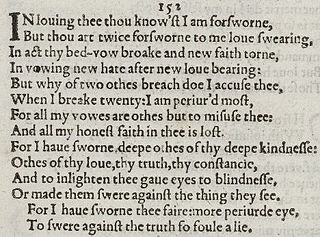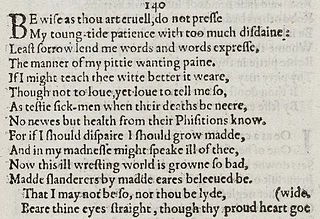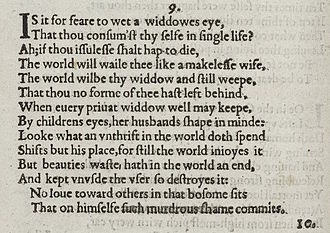
Sonnet 2 is one of 154 sonnets written by the English playwright and poet William Shakespeare. It is a procreation sonnet within the Fair Youth sequence.

Sonnet 10 is one of 154 sonnets written by the English playwright and poet William Shakespeare. It is a procreation sonnet within the Fair Youth sequence.

Sonnet 38 is one of 154 sonnets written by the English playwright and poet William Shakespeare. It is a member of the Fair Youth sequence, in which the lyric subject expresses its love towards a young man.

Sonnet 48 is one of 154 sonnets written by the English playwright and poet William Shakespeare. It is a member of the Fair Youth sequence, in which the poet expresses his love towards a young man.

Sonnet 49 is one of 154 sonnets written by the English playwright and poet William Shakespeare. It is a member of the Fair Youth sequence, in which the poet expresses his love towards a young man.

Sonnet 50 is one of 154 sonnets written by the English playwright and poet William Shakespeare. It is a member of the Fair Youth sequence, in which the poet expresses his love towards a young man. It is continued in Sonnet 51.

Sonnet 51 is one of 154 sonnets written by the English playwright and poet William Shakespeare. It is part of the Fair Youth sequence, in which the poet expresses his love towards a young man. It is a continuation of the argument from Sonnet 50.

Sonnet 63 is one of 154 sonnets published in 1609 by the English playwright and poet William Shakespeare. It is one of the Fair Youth sequence. Contrary to most of the other poems in the Fair Youth sequence, in Sonnets 63 to 68 there is no explicit addressee, and the second person pronoun is not used anywhere in sonnets 63 to 68.

Sonnet 97 is one of 154 sonnets written by the English playwright and poet William Shakespeare. It is a member of the Fair Youth sequence, in which the poet expresses his love towards a young man. It is the first of three sonnets describing a separation between the speaker and the beloved.

Sonnet 152 is a sonnet by William Shakespeare. It is one of a collection of 154 sonnets, dealing with themes such as the passage of time, love, beauty and mortality, first published in a 1609.
Sonnet 149 is one of 154 sonnets written by the English playwright and poet William Shakespeare.

Sonnet 148 is one of 154 sonnets written by the English playwright and poet William Shakespeare.

Sonnet 140 is one of 154 sonnets written by the English playwright and poet William Shakespeare. Sonnet 140 is one of the Dark Lady sonnets, in which the poet writes to a mysterious woman who rivals the Fair Youth for the poet's affection.

Sonnet 139 is one of 154 sonnets written by the English playwright and poet William Shakespeare.

Sonnet 90 is one of 154 sonnets written by the English playwright and poet William Shakespeare. It is a member of the Fair Youth sequence, in which the poet expresses his love towards a young man.

Sonnet 96 is one of 154 sonnets written by the English playwright and poet William Shakespeare. It is a member of the Fair Youth sequence.

Sonnet 111 is one of 154 sonnets written by the English playwright and poet William Shakespeare. It is a member of the Fair Youth sequence, in which the poet expresses his love towards a young man.

Sonnet 114 is one of 154 sonnets written by the English playwright and poet William Shakespeare. It is a member of the Fair Youth sequence, in which the poet expresses his love towards a young man.
Sonnet 120 is one of 154 sonnets written by the English playwright and poet William Shakespeare. It's a member of the Fair Youth sequence, in which the poet expresses his love towards a young man.

Shakespeare's sonnet 117 was first published in 1609. It uses similar imagery to Sonnet 116 and expands on the challenge in the closing couplet. Using legally resonant metaphors, the poet defends himself against accusations of ingratitude and infidelity by saying that he was merely testing the constancy of those same things in his friend.




















